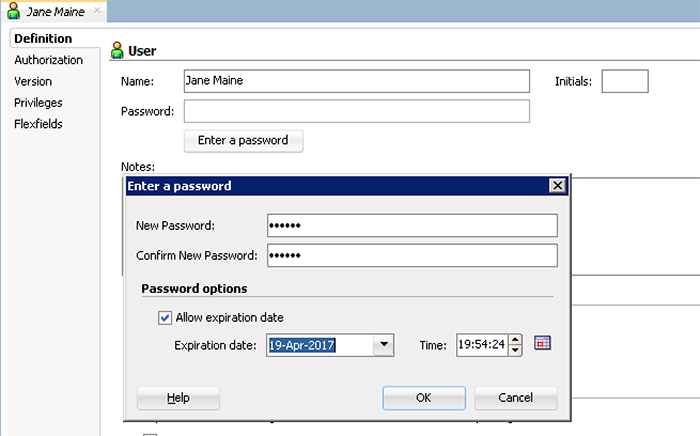Creating Security Profiles in ODI 12c

As a newcomer to ODI I enjoy hearing from the more seasoned veterans about common situations they encounter on projects. One of these recurring situations (especially if the company has a very small dev team) is the lack of security. I will not discuss how Oracle improved security by using public/private key pairs for Cloud services, external hackers or any of the buzz words the media likes to toss about. But, I will share with you an easy way to create profiles in ODI to setup a more secure work environment.
Generally speaking, security is neglected because admins, operators or users are not aware of how to set it up or they find it too limiting and tedious to deal with. Other times you might see the exact opposite, where someone has it so locked down you have to request project permissions on the hour just to get work done (Pro-tip: never let control freaks setup or manage security! Just kidding. Maybe.)
Prior to starting any security profile setups, make sure to sit down and really put some thought into the types of profiles you want to create. Think about the different types of work being done in ODI (developer, operator, etc) and what level of permission someone may require. <a href="http://bit.ly/SecurityProfiles" target=_"blank">Review the built-in generic profiles here. Keep in mind that you will need to setup security in each environment (Dev, Test, QA, Prod and any others you might use) that you want to connect to. No security setup 'automatically' transfers over to other environments, and not all users require access to each environment.
In this tutorial we will take into consideration the following users:
- DI Projects Developer - Level I
- Senior BI Project Manager
- Consultant
NOTE: This tutorial is specific to ODI internal password storage and authentication, not external authentication.
The first step is to decide what type of security profile (access) each user will need.- DI Projects Developer - Level I: Entry level DI developer. Should be able to develop in select projects only. Should also have 'view-all' access across the environment
- Senior BI Project Manager: Full access to all related tasks in Designer, Operator and Topology. Might also have ability to edit or create new users.
- Consultant: Brought in to assist in developing mappings and to load new data from a recently acquired company Ok, now we can begin the setups.
- In a work environment you will login using an ADMIN or Security Profile that has the credentials to create security profiles. In our example you are assumed to be logged in as Admin, Training or Supervisor and have the correct access to set the profiles up.
- Navigate to the Security tab in ODI.
 If you do not see it, go to the very top menu and click Window > ODI Security Navigator (seen below)
If you do not see it, go to the very top menu and click Window > ODI Security Navigator (seen below)

Now we will create the User logins that will be linked to each profile.
Most of you will already have User logins, just double-click the specific 'User Profile' when logged in under the ADMIN or full access account to edit permissions for the User. - Expand the 'Users' accordion and click 'New User' to open up the properties window

Create a login for Jane Maine, our Level I ETL Developer. Assign her the profiles that will allow strictly regulated access in the Designer Navigator to projects and models but allow her view access for everything. (Review the profile descriptions)
We see that in order to limit her development access in DEV to specific projects and models in the Designer Navigator, we must use the non-generic profiles NG_DESIGNER and NG_VERSION_ADMIN. We also must include CONNECT so she has the option to connect to DEV.Fast Review: An object is a representation of a design-time or run-time artifact handled through Oracle Data Integrator. Examples of objects include agents, projects, models, data stores, scenarios, mappings, and even repositories. An instance is a particular occurrence of an object. For example, the Datawarehouse project is an instance of the Project object. A method is an action that can be performed on an object, such as edit or delete. Generic profiles allow access to all methods of all instances of an object. Non-generic profiles are not authorized for all methods on the instances, an admin must grant rights on the methods for each instance.
- Input Jane's information and assign her a password (abc123) by clicking 'Enter Password'. Make sure that Jane's password will expire in 6 months, forcing her to change it for security purposes. Click 'OK'
Best Practice: Always go in to your account and change any temporary password. See the video on how to do that, here.
 Your screen should now look like this (description is optional - I always add them in):
Your screen should now look like this (description is optional - I always add them in):

- On the same properties window click the 'Authorization' tab on the top left side. We are granting very limited access because her projects, as a entry level developer, are limited. Click 'Projects' and allow her access to all methods within 'Projects'. Select all methods (use the checkmark in the top left of each objects) from the following: Select SAVE after each object group methods have been selected:
- Column
- Condition
- Diagram
- Folder
- Interface
- Load Plan
- Mapping
- Package
- Procedure
- Procedure Command
- Scenario
- Scenario Variable
- Now we create the User and Profile for a recently hired Senior BI Manager named Will Doe. Following the same steps, create the User by expanding (or locating) the Users accordion and clicking New User. Make sure to set the password to expire in 6 months.
- Unlike the entry level employee, Will Doe needs full access as Senior Manager but he does not need Supervisor access. Check each generic profile (do not check any that start with NG) and click save. Your screen should look similar to the image below.
 Pro Tip: If you aren't sure your security settings are correct, after your new user/profile is saved, expand the 'Objects' and/or 'Instances' (orange boxes on the screenshots above) under the Users name and see what is available.
Now we need to create the Consultants general User and profile. The Consultant password does not need to expire, since we will let the account expire after a month.
Pro Tip: If you aren't sure your security settings are correct, after your new user/profile is saved, expand the 'Objects' and/or 'Instances' (orange boxes on the screenshots above) under the Users name and see what is available.
Now we need to create the Consultants general User and profile. The Consultant password does not need to expire, since we will let the account expire after a month.
- Create a new User under the Users accordion. Use the name: 'Consultant', Password: abc123, Notes: Temp consultant for ETL DEV work only. In this situation, the consultant will need nearly full access but not total access to everything. Check all of the generic profiles EXCEPT version admin. Select the NG VERSION ADMIN to allow selective version access. Your screen should look similar to below.
- Click on the 'Authorizations' tab on the top left and scroll down in the objects list and select 'Version' and check only Compare, Restore and View. Click Save. Your image should look similar to below.
- This screenshot shows how Jane Maine can only access Projects and Load Plans, but not any of the models. What are differences you see for your profiles?




 Now we test our user settings. Disconnect ODI and login using each USER you created. Look at the limitations for each user.
Now we test our user settings. Disconnect ODI and login using each USER you created. Look at the limitations for each user.
 There are so many options for creating secure Users and Profiles within ODI that allow the appropriate amount of access with maximum security - and in fact, it's fairly easy. You can block out high level access such as the entire Operator Navigator or Designer Navigator, all the way down to granular level security where you can block out very specific Methods and Objects associated with it.
A word to the wise: It is strongly suggested that you only use a generic SUPERVISOR or ADMIN account that has full ODI access for creating users, profiles, changing passwords, etc. Create your own personal user/profile to perform daily work. The reason for this is to know who specifically is doing what. If the user is assigned ADMIN (or something generic) then there is no way to tell who used the login.
Other suggested settings to try out: You can create Users and Profiles for admin purposes including a 'Designer Navigator only' access, 'Topology Navigator only' access, 'Operator Navigator only' access and variations where you can only access the Designer Navigator and Toplogy navigator, but not the Operator tab.
There are so many options for creating secure Users and Profiles within ODI that allow the appropriate amount of access with maximum security - and in fact, it's fairly easy. You can block out high level access such as the entire Operator Navigator or Designer Navigator, all the way down to granular level security where you can block out very specific Methods and Objects associated with it.
A word to the wise: It is strongly suggested that you only use a generic SUPERVISOR or ADMIN account that has full ODI access for creating users, profiles, changing passwords, etc. Create your own personal user/profile to perform daily work. The reason for this is to know who specifically is doing what. If the user is assigned ADMIN (or something generic) then there is no way to tell who used the login.
Other suggested settings to try out: You can create Users and Profiles for admin purposes including a 'Designer Navigator only' access, 'Topology Navigator only' access, 'Operator Navigator only' access and variations where you can only access the Designer Navigator and Toplogy navigator, but not the Operator tab.
